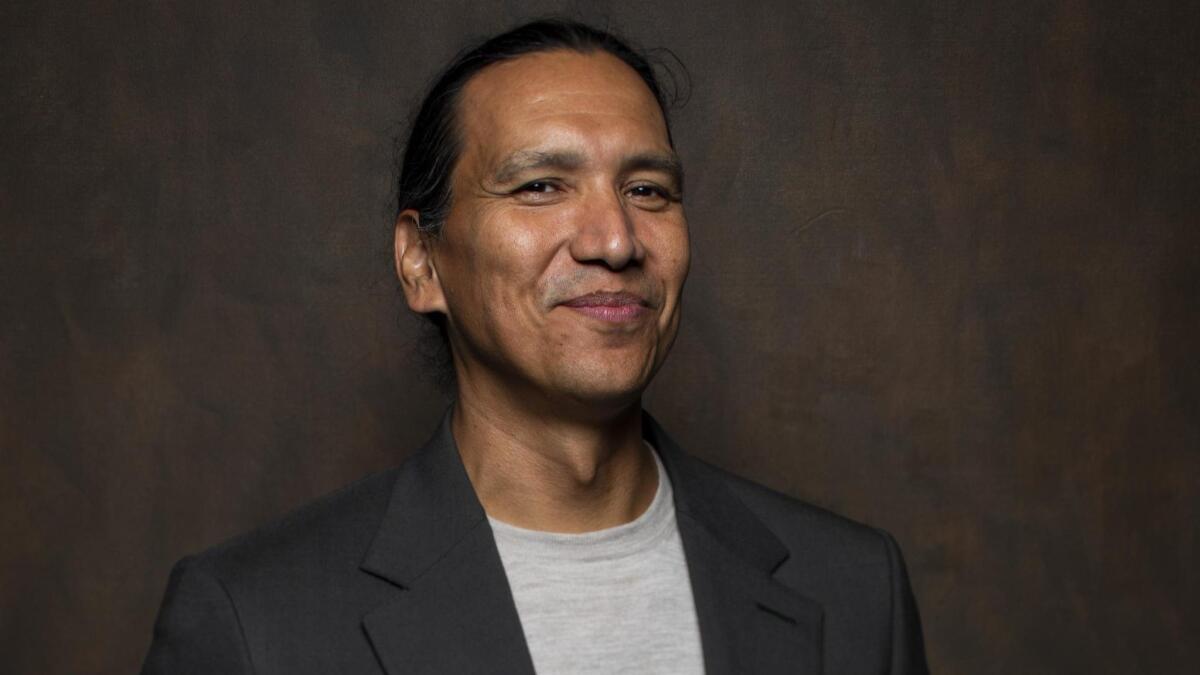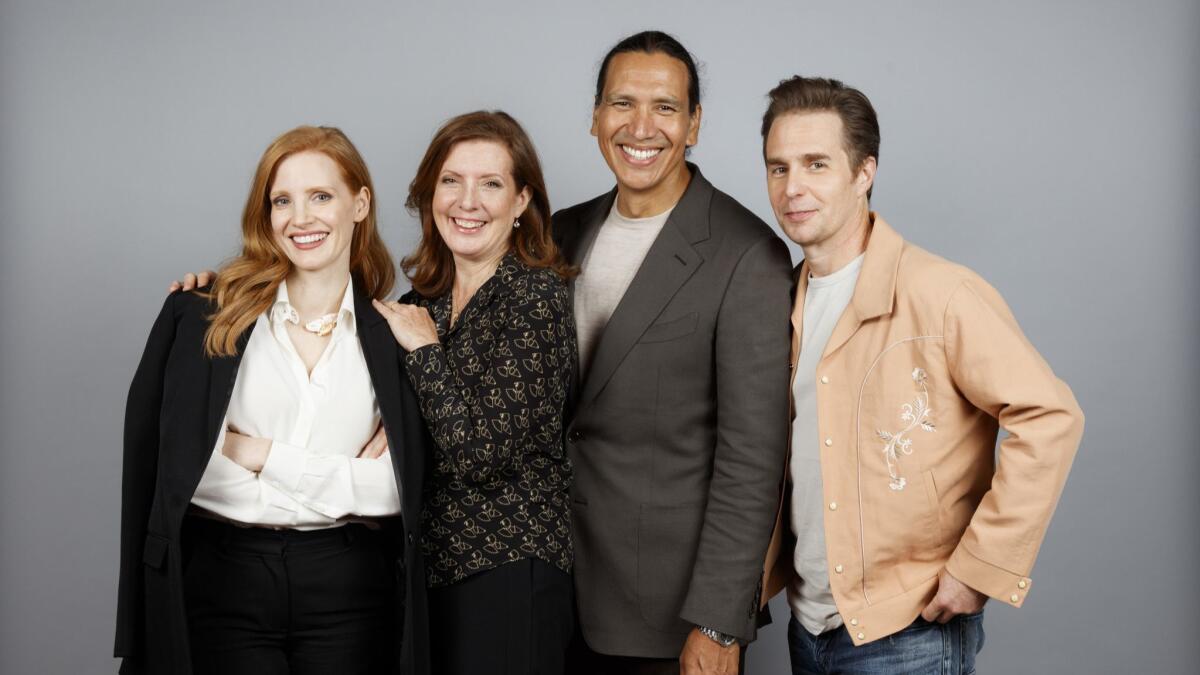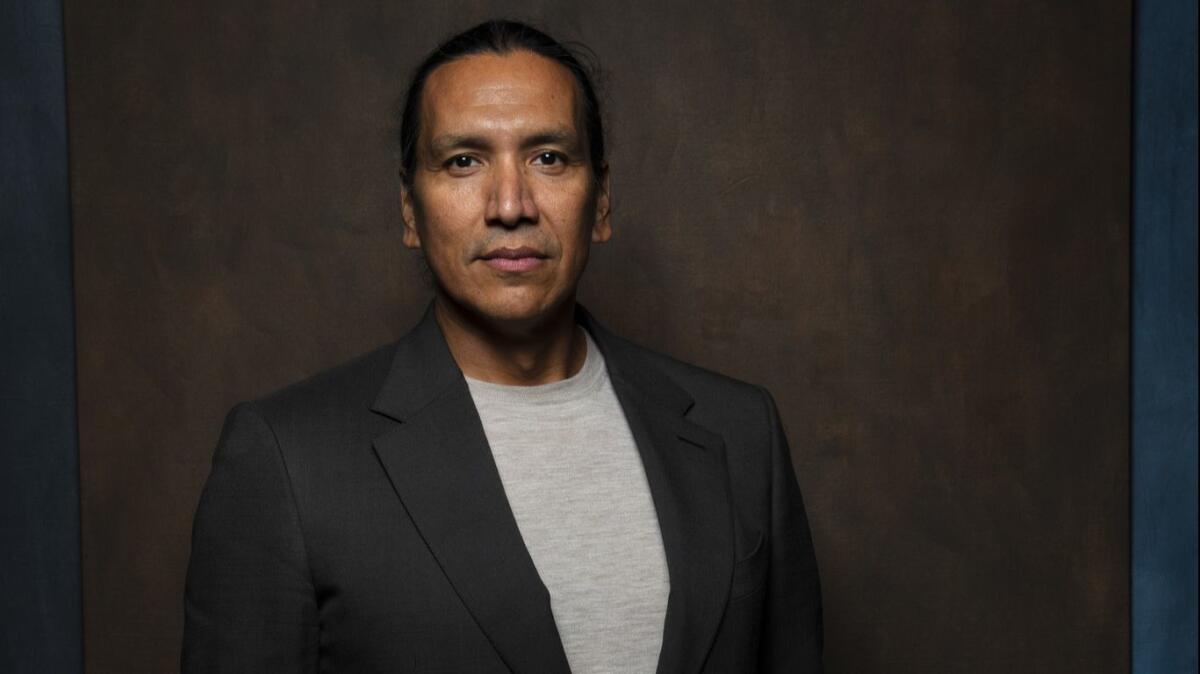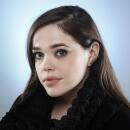As Sitting Bull in ‘Woman Walks Ahead,’ Michael Greyeyes continues to educate through Native roles

- Share via
Growing up in the Canadian province of Saskatchewan, Michael Greyeyes always felt close to his indigenous roots. Though he was raised in the city, he and his family would travel from Saskatoon to the Plains Cree reserve nearly every weekend for powwows or tribal gatherings.
But at age 9, Greyeyes was accepted into Canada’s National Ballet School, so his entire family migrated east to Toronto. Still, his ancestry remained vital to him. When he transitioned from dance to acting, he was always cast in Native roles, allowing him to learn about iconic characters like Crazy Horse and Wandering Spirit. For his latest role in “Woman Walks Ahead,” the 51-year-old year old plays arguably the most recognizable figure in Native history: Chief Sitting Bull.
The film, which is available on demand via DirecTV ahead of a June 29 theatrical release from A24, is based on a true story about the friendship between the Hunkpapa Lakota leader and Catherine Weldon (Jessica Chastain), a widowed painter who traveled to North Dakota on a quest to paint Sitting Bull in the 1880s.
Greyeyes spoke with The Times from his home in Toronto, where he lives with his wife and two children, and serves as a theater professor at York University.
You said you responded to the script because Sitting Bull was not depicted as a stereotypical noble savage. How did the story veer away from those cliches?
Almost immediately, I recognized his humor — how funny he was on the page. And that, I think, is the most rare thing that I see in scripts not written by us about our communities and about our heroes. I’ve always looked at humor as a sign of awareness and intelligence. He was politically very, very astute. He understood people, he understood the cost of war and he had witnessed destruction and illness. So all these notes that were in the script told me right away that I was looking at a landmark portrayal.
Growing up, did you see yourself reflected on-screen?
I didn’t see myself reflected at all. I saw ridiculous representations of what people thought we were. But I grew up in my community — I grew up with my family around me — so I knew who we were. And there was this strange disconnect with that knowledge and what I saw on-screen… And then around the time I was actually transitioning from dance into film was the era of “Dances With Wolves” and “Last of the Mohicans.” I was actually starting to see depictions that weren’t caricatures and were nuanced. When I saw those faces — faces that looked like mine on the screen — it changed how I looked at my career.
When I saw “Dances With Wolves,” I was living in New York City, and maybe a month or two after seeing it, I was walking back to the East Village with my girlfriend and said, “I think I’m going to become an actor.” She just looked at me and said: “That’s fantastic.” And she didn’t even blink. So when you see yourself on-screen, it opens up that door to the possibility of it. And that’s what sort of galvanized my choice.
Comanche actor Gil Birmingham recently said he’s rarely cast in “crossover parts” where he isn’t playing a Native. Has that been your experience?
Interestingly, until about a week ago, I’d never been cast as a non-Native actor. I’ve played doctors, I’ve played a serial killer, I’ve played police officers, I’ve played soldiers — but they were always Native. Never did I land a role — and I certainly auditioned for them — in which the character wasn’t seen as Native. I actually think there’s a sea change. I’m quite hopeful about my industry. I see the change in the writing and the depictions of characters.
Just last week, I saw a beautiful episode on “Westworld” with Zahn McClarnon — and I was like, “It’s not just me.” The writing is getting better. They’re allowing our actors more room to stretch. And I think with that, the industry itself will go, “OK, they obviously can play beautifully — how else do we see you?” “We like this actor. Maybe she’s gonna be on ‘This Is Us.’’’ I think we’re on the eve of that transition.
Last year, Saulteaux actor Adam Beach wrote an open letter arguing that the industry needed to stop casting non-Natives in Native roles. Do you agree?
Casting Native people in Native roles should be a no-brainer. First of all, we’re bringing in a certain kind of cultural, social, political knowledge that we grow up with — that’s our lived experience. Our personal histories can help elevate writing and shift it and transform it from something that’s stereotyped into something that’s more three-dimensional. I think you automatically lose that when you cast outside the community.
There has been some question of how the industry can appropriately vet the ancestry of Native actors.
It’s tricky, but it’s also quite easy to ask questions. Within communities, the ideas of kinship and family knowledge — we know each other. I know that maybe sounds strange, but the actors that I’ve worked with, I know other actors who have worked with them, and in some cases, our families know each other. So in a way, I never have to question what that actor’s background is because I know they’re from communities that are like my own. There’s sort of a kinship that we share. We sort of recognize each other. When an outsider appears, there’s a strange gap — like, “Do you know this person? Do you know their family?” I think it’s incumbent on the casting process to cast a wide net. Sometimes it takes longer, sometimes you have to do more work and really beat the bushes. But when you do, I think the community has a really rich array of performers.
“Woman Walks Ahead” is set on the Standing Rock Indian reservation in North Dakota. Did that feel odd, given the recent battle over building an oil pipeline on sacred tribal burial grounds there?

When we were making the film, the Dakota Access Pipeline protests were unfolding to the north of us. It’s really actually quite powerful to come to set every day and recognize that some hundred plus years have passed, but the underlying political landscape remains exactly the same. The state wants our land either for access or to mine it of its resources. And here we were making a film about one man and his community’s struggle to resist the state taking everything. To me, that was quite sad, to recognize that truth — but also as an artist, I was so passionate about the work and the political message that the film gives. Literally, time has passed and nothing changed. We are still in the way of the conquest.
You’re a tenured professor at Toronto’s York University. How would you describe your teaching style?
I think I’m really passionate. That’s what students have told me. When I don’t like something, when I have criticism, I’m rather blunt about it. I literally don’t sugarcoat it. But when I love something, I’m effusive, I’m over-the-moon. So when they blow me away, they know it. I think that’s what I bring to the classroom, is a real honesty with them. I think also the fact that I’m so involved in my industry, it allows them to recognize that I’m teaching them something that I do instead of something that I used to do.
Does it ever bother you that your family name is Greyeyes, even though you have brown eyes?
The ancestor whose name was “Greyeyes” came from the U.S., from the Wyoming area. When he moved to Canada, his last name was “Steele.” He had these startling gray eyes, so that was the name he was called — and many of his children took that name. It’s interesting to note that some people in the family didn’t want to have a truly Indian sounding name; they choose Steele. I love it, and it’s hilarious, because whenever I’m out east, people go, “That’s a beautiful, unique name.” But when I go home, it’s like John Smith. There are so many people with that name.

Follow me on Twitter @AmyKinLA
More to Read
Only good movies
Get the Indie Focus newsletter, Mark Olsen's weekly guide to the world of cinema.
You may occasionally receive promotional content from the Los Angeles Times.











